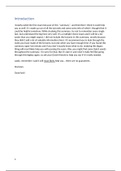Introduction
I totally nailed the first exam because of this ‘’summary’’, and therefore I think it could help
you as well. It’s made up out of all the tutorials and some extra info of which I thought that it
could be helpful somehow. While studying this summary, try not to remember every single
fact, but understand the big lines very well. It’s a multiple-choice exam and it will be a lot
easier than you might expect. I did not include the lectures in this summary, mostly because
they didn’t add a lot of valuable information (imo). I’d recommend you to look through the
notes you have made of the lectures, but only when you have enough time. If you found this
summary super last minute and if you don’t exactly know what to do: studying this bigass
thing will most likely help you with passing the exam. Btw, you might find some Dutch words
throughout the summary. I’m sorry for that. But it’s late rn and I don’t really feel like going
through this bigboy again, so ask your Dutch friends to help you out if it’s really needed.
Lastly, remember I said it will most likely help you… there are no guarantees.
Anyways,
Good luck!
1
,BMS- Lego bricks of life tutorial 1
Questions? >>>s.chanda@student.maastrichtuniversity.nl
Sugars
Glucose, Fructose, Ribose, Maltose
Mono-, di- and polysaccharides
Energy
Storage
Insulin/glucagon
Blood
Fats
Essential for life
Synthetic/natural (cis-trans)
Omega 3
Storage
Energy
PS: What kind of fats and sugars exist?
Learning goals:
1. What types of fat exist and what is their structure?
2. What types of sugar exist and what is their structure?
3. Which fats and sugars are healthy and which aren’t?
4. What are the functions of sugars and fats?
5. What are the most important fats?
6. How do you chemically name sugars and fats?
7. How are sugars and fats broken down and digested?
Book recommendation: Khanacademy.com, Youtube, introduction to biochemistry by
Bettelheim, Molecular biology of the cell by Alberts
Printing: ricohmyprint
2
,LG1(+6): What is the structure of a fat?
Triglyceride, aka fats/oils. Also known as
triacylglycerol formed in a reaction between a
glycerol molecule and three fatty acid molecules.
The fatty acids are called fatty because the
hydrocarbon tail won’t dissolve well in water; it’s
hydrophobic. They are called acid because the
carboxyl group of a fatty acid (COOH) tends to be
acidic; it easily donates a hydrogen.
This means that in a condensation reaction between glycerol and the three fatty acids a
bond can be formed, leading to a triglyceride with water as a side product (see picture).
This reaction is called ‘’esterification’’(=verestering); an alcohol and a carbon acid react
together to a bigger molecule with water as a side product.
Some fatty acids have one or more double or triple bonds in their hydrocarbon tail and are
said to be unsaturated, these fats are liquid.
Cis-configuration: when the hydrogens are in the same side (both on top of their c
molecules, or below their c molecules) This type of configuration has a kink in it. Used by the
body for hormone regular. Fatty acids with no double bonds are saturated, these fats are
solid because their structure is more stable. So-called trans-configuration; H is on the
opposite site of the other hydrogens. These fats are liquid-fats that are converted to solid-
fats during food processing techniques. Unhealthier than cis-configuration.
Fat nomenclature: e.g. C16: 0
16= 16 c atoms
0= zero double/triple bonds
Note: with omega fats you start counting at the end (opposite of the glycerol molecule)
Omega-3 (n-3): first double bond on the third C
Omega-6 (n-6): first double bond on the sixth C
Omega-9 (n-9): first double bond on the ninth C
Weird case, might come back on the exam:
18:2 (omega-6)= first double bond on the 6th c atom, second double bond on the 9th c atom.
Cis-6,9 octadecanacid= cis-configuration, double bonds on 6th and 9th c, octadeca= 18 so 18 c
atoms.
3
, What types of fats (lipids) exist?
Lipids: insoluble in water, but soluble in benzin, alcohols, etc. (organic solvents) because
they’re both polar.
Triglycerides: Fatty acids are stored as an energy reserve through a linkage to glycerol to
form triacylglycerols (triglycerides). This process is described above.
Lipid Aggregates: Fatty acids have a hydrophilic head and a hydrophobic tail. In water they
can form a surface film or small micelles. Whereas triglycerides can form fat droplets,
phospholipids and glycolipids form self-sealing lipid bilayers that are the basis for all cell
membranes.
(a)Phospholipids: The major constituents of cell membranes. In phospholipids, two
of the -OH groups in glycerol are linked to fatty acids, while the third -OH group is
linked to phosphoric acid. The phosphate is further linked to one of a variety of small
groups, such as choline. Phosphor group is hydrophilic.
(b)Glycolipids: these fat-molecules are basically the same as phospholipids, however
the hydrophilic head contains one or more sugars and, unlike phospholipids, no
phosphate.
(c) Steroids: Steroids have 4 rings of carbon. Example: cholesterol ( two types: LDL
cholesterol (bad) and HDL cholesterol (good) it removes some of the excess cholesterol =
Low/high density lipoprotein)
4






